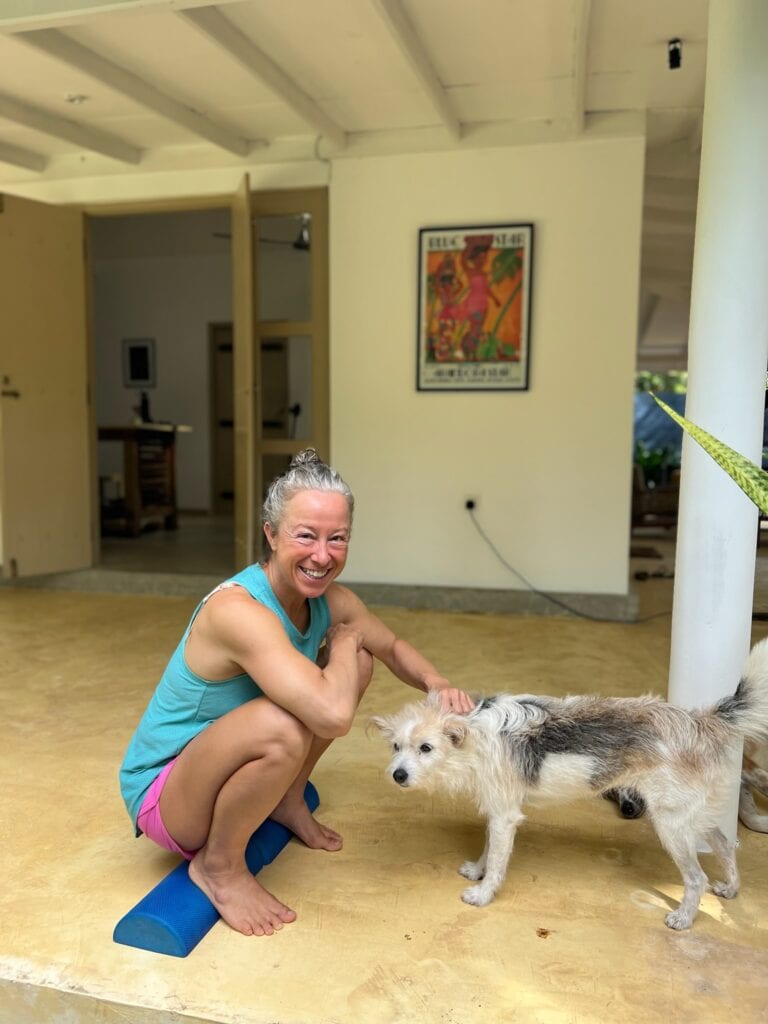UPDATED: April 18, 2025
Are you tired of your heels popping up when you squat?
Squatting is a natural human movement pattern – one that delivers loads of benefits for our bodies and enhances our daily lives – but after too many years sitting in chairs & wearing shoes, many of us have lost our comfortable resting squat.
When your heels persistently lift up as you squat down, you may simply need a bit more ankle dorsiflexion mobility.
So today I’m sharing three practical techniques to increase your ankle mobility so you can get your heels down when you squat (and a bonus tip on how it really might be more about your hip mobility than your ankles). Get ready to step-up your squat game with key mobility tools to improve your technique!
Mobilize Your Ankles
Ready to jump in? Here’s what you’ll need:
✅ Half round foam roller (or a towel or rolled up yoga mat)
✅ Small rubber eraser or rolled up sock (optional)
✅ Elastic band (thicker, heavier option to create some pull) & a strong, stable vertical attachment such as a sofa leg
(or, if you prefer to read, scroll down to learn more about the exercises)
3 Exercises To Improve Your Ankle Mobility
Here’s why I chose the exercises & techniques I shared in the video class.
#1 Stretch your tight calf muscle
Prolonged periods of sitting in chairs & wearing shoes with elevated heels can lead to tight calf muscles. This can restrict your ankle mobility, making it difficult to keep your heels down while squatting.
Luckily, regularly stretching your calves can decrease tightness and help improve your ankles’ range of motion. This simple exercise is on my list of go-tos because it’s soooo easy to incorporate into your regular life. You can do it multiple times a day until you find your calves aren’t as tight and tense – like while you’re brushing your teeth or making coffee – no extra time required!!
#2 Spend time in a bolstered squat
If you find it challenging or impossible to squat with your heels down, try elevating your heels by placing a small object (such as a half foam roller or a rolled-up towel) under them.
This gets your squat closer to your true calf & ankle range of motion. This is magical because it means you’re giving your body a gentle signal that you want to have more ankle mobility. Your body can hear gentle signals like this, and over time will actually give you more range of motion.
In contrast, if you blow past your true range of motion, your body will have to resort to a compensation strategy – which is why your heels lift.
When you’re compensating, you’re not adapting or creating change.
So simply supporting your heels in your resting squat will help you get more squatting range of motion over time (and at the same time, you’ll be getting the other benefits of being in a resting squat position).

#3 Mobilize your feet to mobilize your ankles
Ankle mobility isn’t just about your ankles! Since your ankles articulate as part of the foot (or they should!), it might be a lack of mid-foot mobility that’s actually what’s holding back your squat.
Individuals with high, stiff arches or who feel a pinch in the fronts of their ankles when they try to dorsiflex may lack the ability to properly pronate their feet. When your foot doesn’t pronate well, the subtalar joint (where your ankle meets your foot) gets stuck, and the result is limited ankle mobility.
This means that for many people, creating some space in that subtalar joint and learning to pronate the foot can be the missing link to increasing dorsiflexion and improving your squatting. Having good pronation mobility is also important for walking, knees, hips & pelvic floor so this is a skill that’s worth working on, even if it seems strange or frustrating at first!
Get your squat back!
Bonus tip – it might not be your ankles that are the problem
While ankle mobility plays a significant role in squatting, we can’t overlook the role of hip mobility. Limited hip mobility will change your centre of gravity in squatting, which can lead to…your heels popping up!
In other words, ankle mobility isn’t the whole story behind your heels lifting, so if the tips in this post don’t help you get your heels down, try working on your hips instead. I created my Start Squatting challenge to help you build better hip mobility and improve your squatting technique. Click here to pick up my FREE Start Squatting Challenge and get working on improving your squat.
Squatting is an essential movement skill for your daily life – and your long term health & mobility. I hope these exercises & tips give you the boost you need to get your ankles down and reclaim your squat!
But remember, consistency is key, so stick with it & commit to practicing these exercises regularly!
And if you’re looking for more great exercises to restore your squat, make sure to sign up for my FREE Start Squatting Challenge right here!
With some patience and perseverance I have no doubt you’ll be squatting comfortably in no time!







